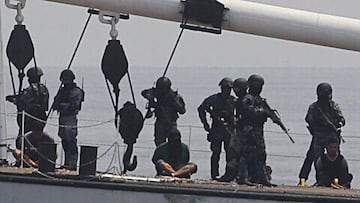Cruise ship passengers asked to close curtains and turn off lights when passing through this common piracy hotspot
The vessel was navigating the waters of the Sulu-Celebes Sea, a region notorious for kidnappings and extortion carried out by pirate organizations.

While sailing through Southeast Asia on its global voyage, Cunard’s Queen Anne cruise ship issued a broadcast to alert passengers of piracy risks in the region. The captain warned of a “heightened security alert” and requested that passengers turn off the lights in their cabins and close the curtains. Additionally, the outdoor promenade deck was closed overnight as a precaution.
The Sulu and Celebes Seas border the shores of Indonesia, Malaysia, and the Philippines—a region historically associated with piracy. In January, the Philippine Coast Guard (PCG) downgraded the threat of crew kidnappings from “moderately low” to “low.” Consequently, the Regional Cooperation Agreement on Combating Piracy and Armed Robbery against Ships in Asia (ReCAAP) advises vessels passing through these waters, like the Queen Anne did recently, to “remain vigilant while transiting the Sulu-Celebes Seas and report any incidents” to local authorities.
Our new Queen has arrived! Welcome to the world Queen Anne. Last night Queen Anne made her grand entrance into her home port of Southampton. It's now only two days to go until the first guests get to embark on the maiden! We are so proud to welcome Queen Anne to the Cunard fleet. pic.twitter.com/NJI9rcMZGM
— cunardline (@cunardline) May 1, 2024
A Cunard spokesperson explained to Business Insider that the announcement was “part of standard maritime procedures” and clarified that there was “no specific threat to the ship or its passengers.”
The Sulu-Celebes Seas have recently seen a period of calm, but their history is marked by piracy and kidnappings. Since 2016, the Regional Cooperation Agreement on Combating Piracy and Armed Robbery against Ships in Asia (ReCAAP) expressed concerns about the rise in maritime kidnappings, with the threat level reaching “high.” It wasn’t until May 2022 that the alert was downgraded to “potentially high,” and finally, in January 2025, the threat level was classified as “low.” However, the region’s legacy of piracy remains significant, with 237 incidents recorded in 2011 alone.
From 18-24 Mar 2025, five incidents of piracy and armed robbery against ships in Asia were reported to the ReCAAP ISC.
— ReCAAP ISC (@recaapisc) March 25, 2025
One incident occurred on board a container ship while anchored at Kandla anchorage, India and one incident occurred to a tug boat while underway in the South… pic.twitter.com/PvXrY7rJNt
Pirate organizations in Sulu-Celebes
Several pirate groups operate in the region, but kidnappings are often attributed to Abu Sayyaf, an Islamic separatist group based in the southern Philippines. According to the US Maritime Administration, Abu Sayyaf received substantial funding from global Islamist networks, including Al Qaeda and Jemaah Islamiyah, during the 1990s and early 2000s. Following the 9/11 attacks and coordinated international efforts against terrorism, the group lost external funding and shifted its focus to kidnappings and extortion in the southern Philippine seas.
USS Coronado sails in the Sulu Sea near the Balabac Strait. The ship is well-equipped for maritime security, including counter-piracy ops. pic.twitter.com/caicoiGhSD
— 7th Fleet (@US7thFleet) February 22, 2017
Kidnapping patterns
Between January 2014 and January 2019, Abu Sayyaf kidnapped 85 crew members in the Sulu-Celebes Seas, with over two-thirds of these incidents occurring in 2016.
The attacks were concentrated within a 250-mile radius stretching from Lahad Datu in Malaysia to the Zamboanga Peninsula in Mindanao, Philippines, crossing the Sulu Archipelago.
The military has declared Basilan free from the presence of Abu Sayyaf bandits after the remaining eight members of the group surrendered on Thursday. https://t.co/UF6YJs96PP pic.twitter.com/8Pr2H7MktV
— The Philippine Star (@PhilippineStar) December 28, 2024
During those years, hostages were taken from fishing vessels (30) and tugboats (32), as well as from yachts, bulk carriers, and heavy cargo ships. On average, captives were held for 151 days—roughly five months.
By the end of January 2019, of the 83 crew members abducted, 45 had been released, 16 were rescued, seven managed to escape, nine died in captivity, and eight were believed to still be held at that time.
Related stories
Get your game on! Whether you’re into NFL touchdowns, NBA buzzer-beaters, world-class soccer goals, or MLB home runs, our app has it all.
Dive into live coverage, expert insights, breaking news, exclusive videos, and more – plus, stay updated on the latest in current affairs and entertainment. Download now for all-access coverage, right at your fingertips – anytime, anywhere.
Complete your personal details to comment